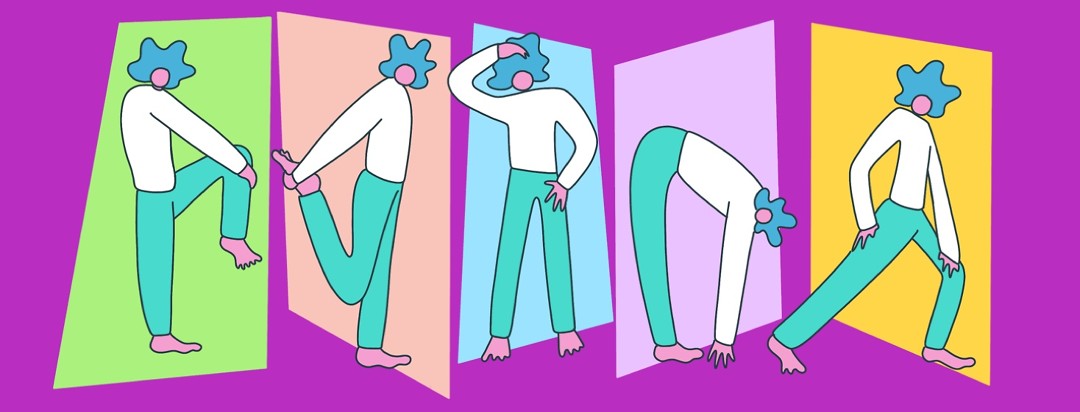Momentary Relief Part 2: Even More Stretches for My Restless Legs
Let’s start by saying restless legs syndrome (RLS) is no fun. The irritating and incessant sensations beneath the surface, leading to an irritating and incessant need to move, is tiresome. It impacts sleep and restricts activities where being confined or staying still is essential.
But on the upside, if you’re fit and well enough RLS is a good excuse to exercise more and increase mobility and flexibility with regular stretching.
What are benefits to regular stretching?
Stretching is a great tool to use in conjunction with strengthening because it helps to lengthen out muscles that have become short and tight. This increases flexibility to allow a good range of motion in the joints.
There are many important benefits to regular stretching, including:
- Reduced pain and stiffness
- Greater range of motion
- Improved muscle function
- Reduced risk of injury
I previously talked about static stretches that are good in confined spaces. Today I want to focus on bigger static stretches as well as dynamic (moving) and active (muscle contraction) stretches.
Calf stretches
I like to work my body from the bottom up so I start with calf raises. Hold onto a steady surface then push up onto the toes, holding for 20 seconds or so. If that’s easy, try raising one leg at a time. Or add a degree of difficulty by slowly raising one foot over two seconds then lowering for two seconds. Repeat about six times on each foot.
Calf raises are a strengthening exercise so I balance with static stretching. As I’m hypermobile I like to stretch on a stair. Hold onto something steady, have one foot with just the toes on the stair, then drop the heel until you feel the stretch. There are several ways to stretch the calf but this is my favourite for RLS - it really seems to get into the calf and alleviate those sensations for a short time.
Quadricep stretches
Next, the quadriceps. These I do standing or lying. Standing on one foot, use the opposite hand to grasp your other foot and pull the leg towards the bottom, pushing the hip forward simultaneously Alternatively lie on your side or belly and pull the leg back.
While this is a stretch I personally find difficult to feel, with a sufficient tilt forward from the hip, it does a great job of alleviating my RLS for a short period of time.
Hamstring stretches
Then the hamstrings. Personally, this is my favourite. Lying on my back I extend one leg into the air - I keep both legs straight because I’m hypermobile, but most people bend both legs a little. Grasp the raised leg as high a possible then pull back towards your chest until you feel a stretch in the back of the thighs. Doing foot circles or flexing and pointing the toes can increase the stretch.
You can also do an active stretch with the hamstring by imagining your pushing the leg towards your chest while pulling it away with your hands. Do this for a few seconds then see if you can increase the stretch.
Another way of stretching the hamstrings is to stand with both feet apart then bend over and reach the hands to the floor. Some of us touch the floor but many people don’t. As long as you feel the stretch it’s doing its job. Try and relax your whole body as you flop forward - it might stretch out a few other bits and pieces as well.
Lower back stretches
A great stretch for my lower back - which is where I feel my RLS originates from - is to lie on the floor with both knees in the air. Spread your arms out wide then slowly lower the knees to one side while keeping both shoulders on the floor and looking in the opposite direction. Pulling the knees further towards your chest will elongate the stretch. Hold for around 20 seconds each side.
Hip flexor stretches
For a hip flexor stretch, sit on the floor with both legs bent back at a 90-degree angle. Press the front knee to the floor, keeping the chest raised high, then lean forward over the knee.
This stretch will activate the hips and possibly the glutes and/or inner thigh - depending on where you have tightness in your body.
Upper body stretch
My final stretch needs a sturdy object to hold onto. Grab onto the object then pull back with both arms. The lower your bottom is to the ground, the greater the stretch. This goes into the shoulders and while I no longer have RLS in my arms, I find stretching anywhere helps and I can balance out my body by doing the top half as well.
Stretching options for anywhere
There are a million more stretches and a quick Google will show up many reputable websites with images and videos for each stretch. I have done most, if not all, of these stretches in parks during a break on a long car trip, or in a corner of an airport lounge when not too many people are looking.
I routinely do them in my living room while watching television. Stretching and strengthening won’t cure RLS but they do ease my symptoms - just for a little while. And getting myself well-stretched right before bed increases my chance of a little peaceful shut-eye.
Do stretches help you find temporary relief for RLS? What kinds of stretches have you tried? Share in the comments below!

Join the conversation